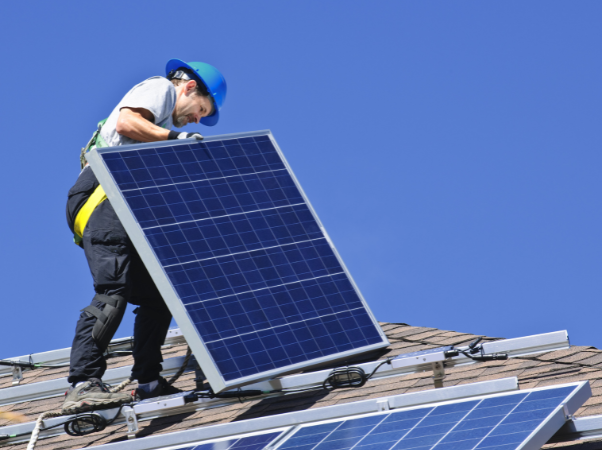Solar Thermal Installer Guide
Solar thermal panels are a common installation for homeowners looking to cut household CO2 emissions and reduce monthly bills.
In this guide, we'll go over everything you'll need to know to begin installing solar thermal for your customers - from the types of solar thermal available to the qualifications you'll need to get started.

Solar thermal panels work by utilising thermal collectors to absorb the sunlight that hits the roof. Once they start absorbing sunlight, they heat up the carrier fluid inside.
A pump then transfers the fluid to a heat exchanger in the solar storage, which is then transmitted to a storage tank that can heat water for the household or building.
What qualifications are needed to install Solar Thermal?
In order to install solar thermal systems for commercial or domestic purposes, you’ll need to be a qualified plumbing & heating engineer with an unvented ticket. It is always highly advisable to attend any manufacturer training before attempting installations.
Installers may need to partner with a roofing firm to acquire additional equipment to safely carry out the roof elements of the installation.
In order to gain a better understanding of the system or to be MCS accredited for solar thermal installation, installers would need to sit a NOS mapped course (which typically takes 3 days to complete).
How long does it take to install a Solar Thermal system?
You can expect the average solar thermal installation to take between 1-2 days from start to finish. Some large or awkward installations may take longer.
What types of Solar Thermal can be installed?
Two types of solar thermal panels are available - evacuated tube collectors and flat plate collectors. The type you install will largely depend on the customers’ preference, budget, and water usage.
Flat plate collectors
Flat plate collectors generate energy via a black absorber surface that faces the sun. The absorber is designed to collect as much radiation as possible, reflecting only a small amount of energy. This energy then heats the thermal fluid which circulates through serpentine copper pipes within the collector, and transfers this heat to the DHW cylinder through a coil.
Flat plate collectors use insulation such as polyurethane foam to insulate the heat they gather.
Advantages of flat plate collectors
- Cheapest type of solar thermal panel available to customers
- Cheaper to install, maintain, and repair
- A robust, reliable solution
Potential disadvantages of flat plate collectors
- Less efficient overall than evacuated tube collectors
- Requires more roof space than evacuated tube collectors
Evacuated tube collectors
Evacuated tube collectors work by absorbing solar radiation from the sun, then utilising a vacuum to insulate the absorbers to virtually negate any heat loss whatsoever - as opposed to the less effective foam used in flat plate collectors. They then transfer the heat from thermal energy to a fluid through a manifold.
Advantages of evacuated tube collectors
- Provides the best solar thermal performance by area available
- Requires less overall roof space than flat plate collectors for a similar output
- Can be easier to handle as tubes are connected individually
Potential disadvantages of evacuated tube collectors
- More expensive than flat plate collectors
- Slightly more difficult to maintain and less robust than flat plate collectors
Can Solar Thermal be installed on any roof?
The main criteria for solar thermal installations is to have a south facing roof that’s in a decent enough condition to effectively mount the panels.
In terms of roof direction, anything between south east and south west should be sufficient enough to generate enough heat for solar water heating. Evacuated tube collectors, being more efficient than regular flat plate collectors, can be laid on both east and west facing roofs to catch the sun as it moves through the sky.
Shade is also an important factor. Before any installation, consider nearby structures, trees, or anything else that may shade the panels, negatively impacting their effectiveness.

Is Solar Thermal compatible with existing hot water systems?
Solar thermal panels are compatible with most existing hot water systems, however the customer will require a solar thermal cylinder to store the heated water generated by solar thermal if they don’t have one already.
Solar thermal cylinders typically have a coil at the bottom for the solar and a second coil above for the heating appliance. In all electric properties any shortfall is made up for by the immersion heater.
Learn More and Become MCS-accredited with City Plumbing and GTEC
We've partnered with GTEC to offer MCS-accredited training to take your renewable installations to the next level.
Learn how to install Solar, Air Source & Ground Source Heat Pumps, EV Chargers, and all other main types of renewable technology. Become certified to upskill your business and take advantage of increased demand ahead of net zero.




